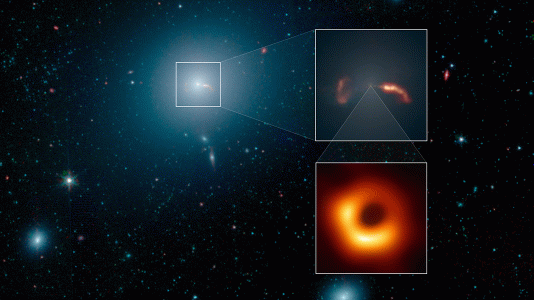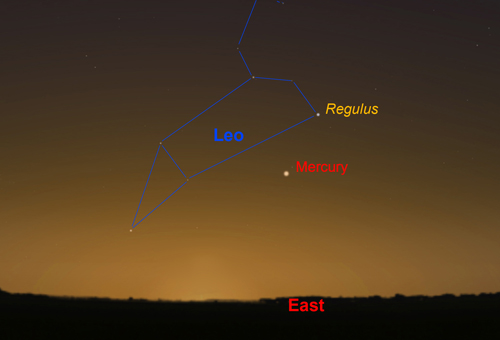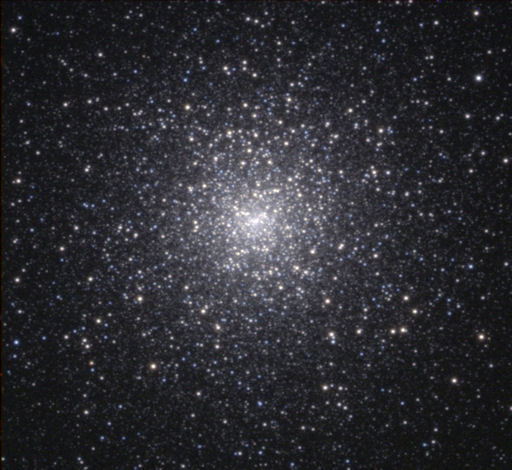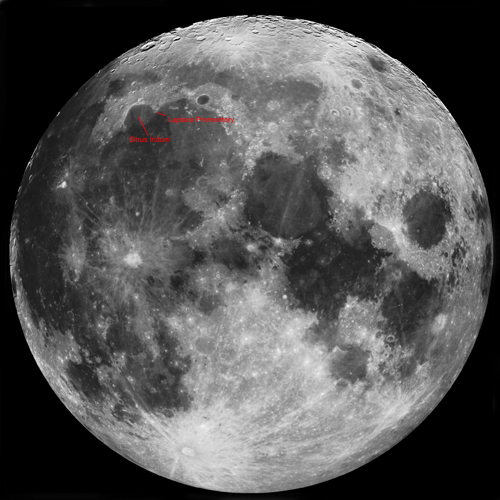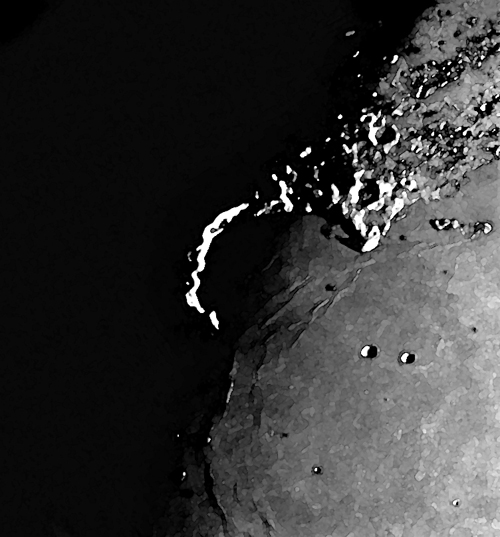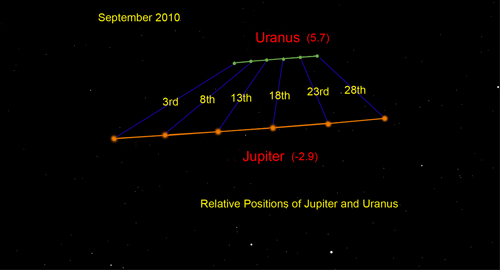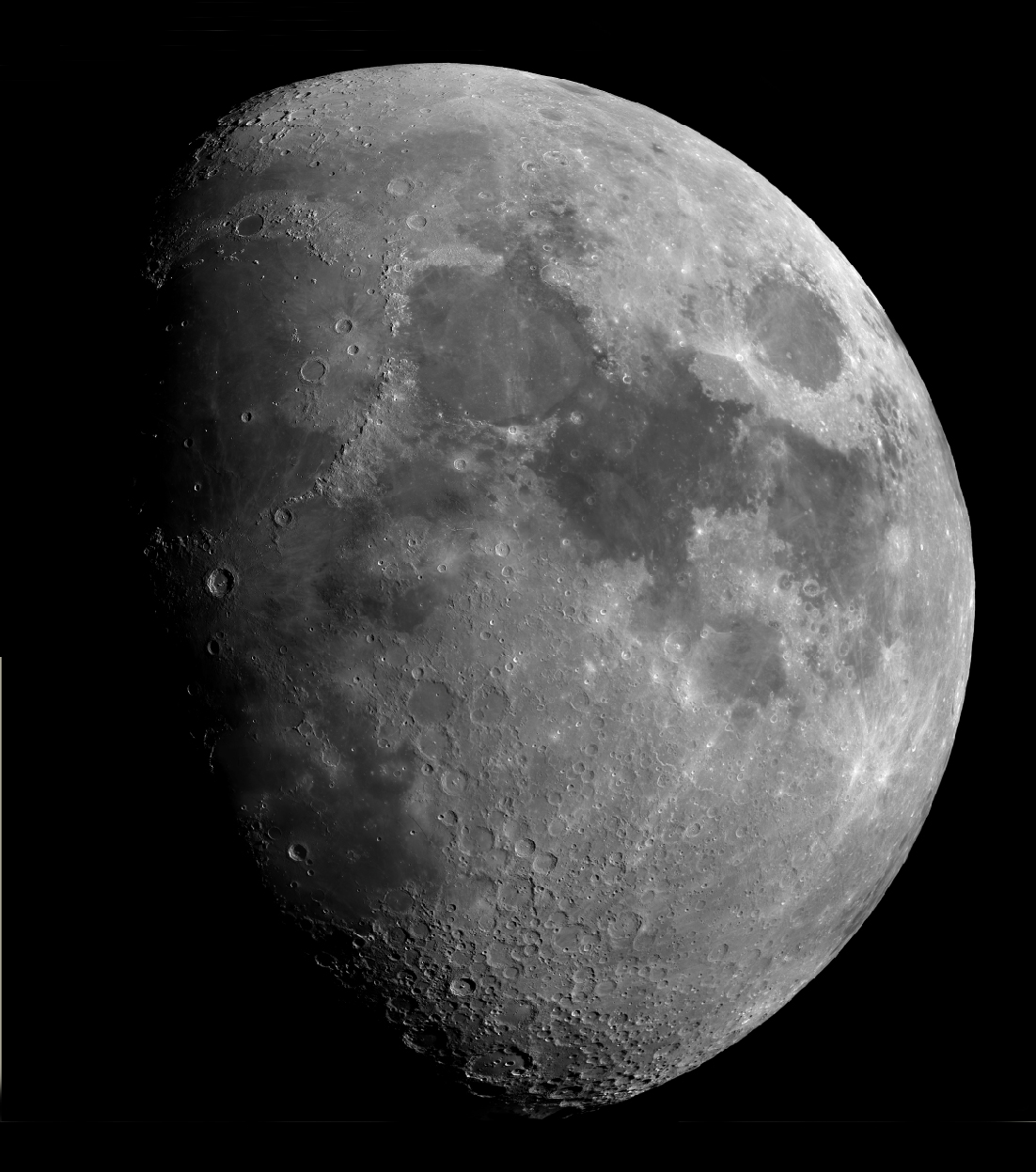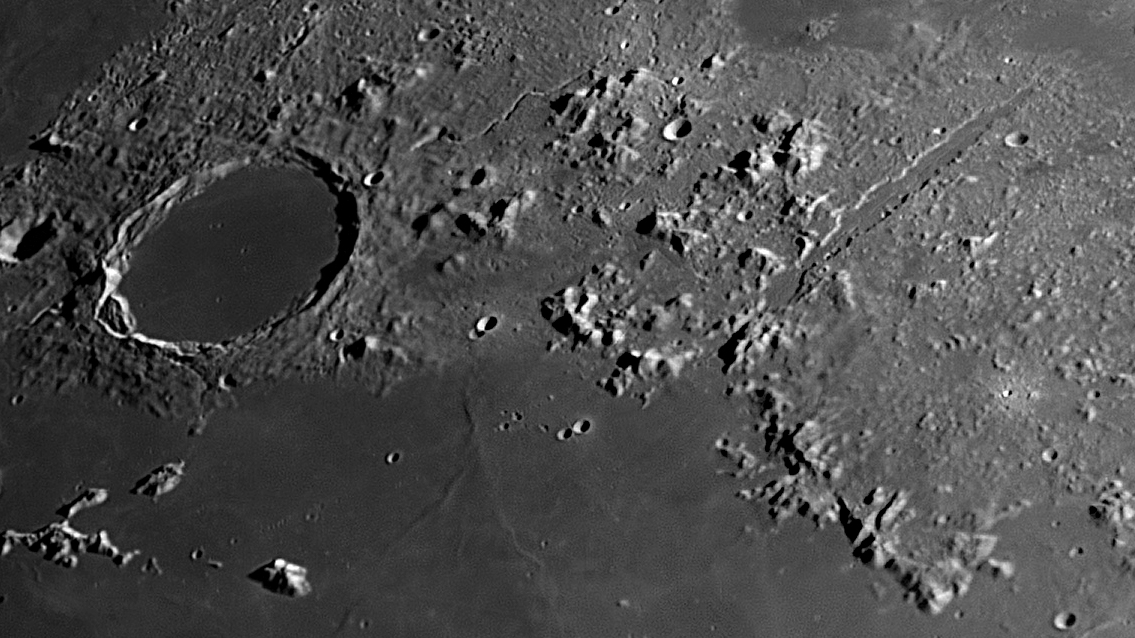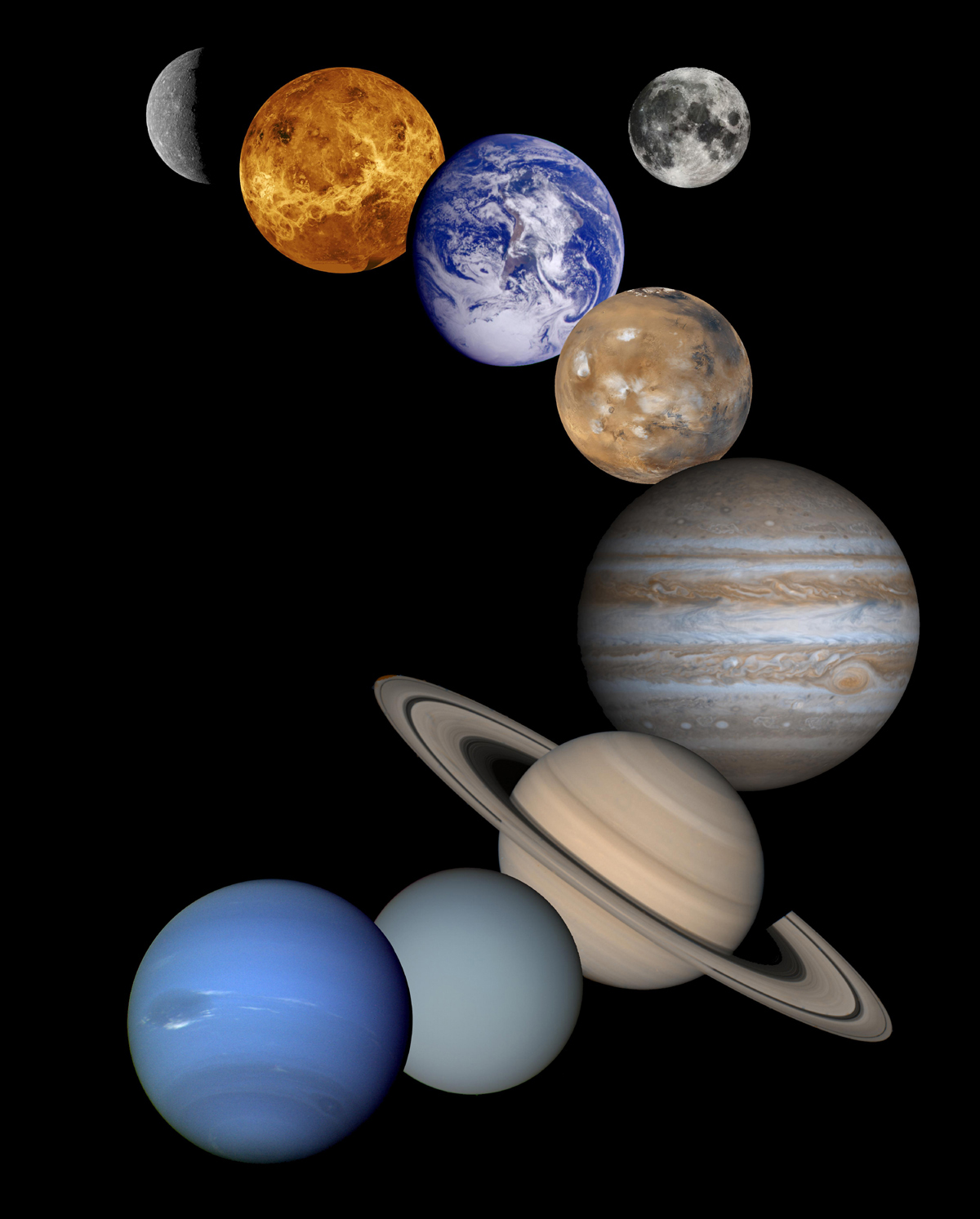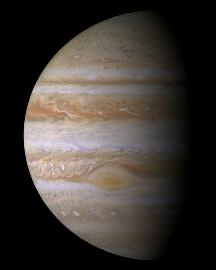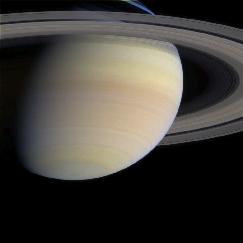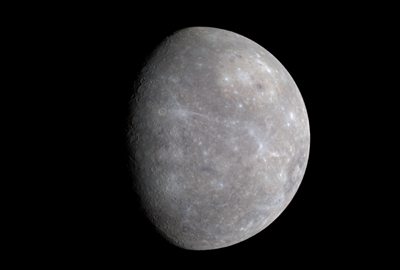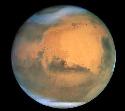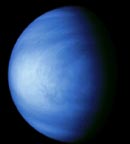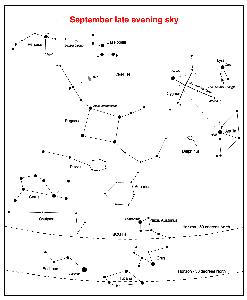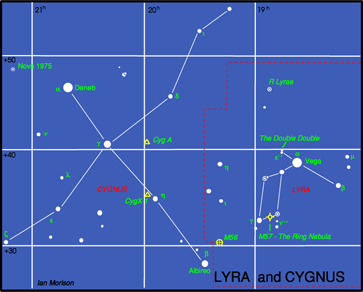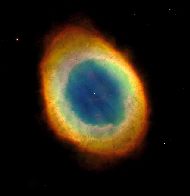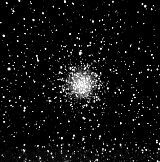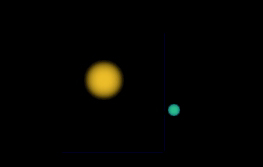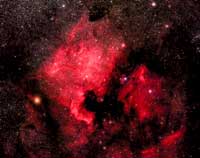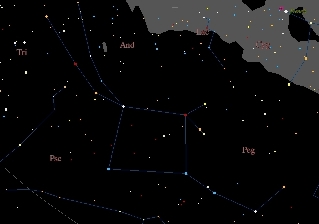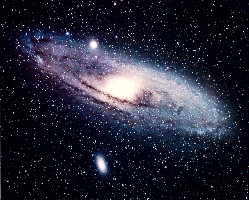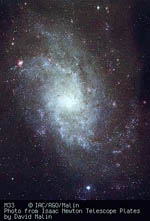The Night Sky September 2010
Compiled by Ian Morison
This page, updated monthly, will let you know some of the things that you can look out for in the night sky. It lists the phases of the Moon, where you will see the naked-eye planets and describes some of the prominent constellations in the night sky during the month.
Image of the Month

Planck Microwave Image of the Sky.
Image:ESA, Planck HFI and LFI.
This is an all sky image of our Milky Way galaxy as seen through the microwave eyes of the Planck Spacecraft. Receivers covering a range of wavelengths have scanned the sky during its first year of operation to show the dust and gas that lies along and, in some regions, well away from the plane of the galaxy. Two of the receiver systems contributing to this image were designed and built by engineers at the Jodrell Bank Observatory, and its scientists are playing a role in the analysis of the data. Away from the foreground structures in the galaxy can be seen a "mottled" red and orange background. This is the Cosmic Microwave Background (CMB) which is the left over radiation from the Big Bang. The patterns show tiny differences in the effective temperature of the radiation due to the "clumpy" structure of matter - both normal and "dark" - just 380,000 years after the Big Bang. It was these fluctuations that allowed gravity to compress the gas and lead to the formation of the first stars and galaxies. As the radio emission from the foreground galaxy varies with frequency, it is possible to unravel it from the CMB background and, in time, Planck will produce the most detailed map of the CMB ever made and which will enable us to understand the evolution of our Universe better.
Highlights of the Month
September 14th to 29th: The best dawn apparition of Mercury this year
A dawn Apparition of Mercury
The latter part of this month gives us the best chance of observing Mercury this autumn in the pre-dawn sky. It reaches its greatest elongation, 18 degrees from the Sun on the 19th when it shines at magnitude -0.3. As, at this time of year, the ecliptic in the dawn sky is well inclined to the horizon, Mercury will reach up to 15 degrees above the horison at dawn, so there is a good chance of seeing it reasonably high in the pre-dawn sky.
A Messier Object imaged with the Faulkes Telescope: M15 - a Globular Cluster in Pegasus.
M15, Globular Cluster in Pegasus, imaged Uplands Community College using Faulkes Telescope North
This image of M15 was taken by students at the Uplands Community College with the Faulkes Telescope North on Hawaii. With an estimated age of 13.2 billion years old, M15 is one of the oldest known globular clusters. It was discovered in 1746 and lies at a distance of ~33,600 light years. M15 shines at magnitude +6.4 so may be easily seen in binoculars by following the line of the two stars that make up the head of the winged horse up towards the left of Delphinus. Its overall luminosity is ~360,000 times that of the Sun and may well have a black hole at its heart. It will appear as a "fuzzy" star in small telescope whilst an 8 inch telescope will begin to show individual stars - the brightest of which has a magnitude of +12.6.
Learn more about the Faulkes Telescopes and how schools can use them: Faulkes Telescope"
September 1st - after sunset: Venus and Mars with Spica
September 1st: Venus, Spica and Mars
Given a good low western horizon at the beginning of the month, you will see a close grouping of the planets Venus and Mars along with the star Spica in the West-Southwest. On the 10th of September they will be joined by a thin crescent Moon with Spica to its upper right, Mars above and Venus to its upper left. By the 11th, the Moon will have moved to the upper left of Venus.
Sept 18th: Sinus Iridum
Sinus Iridum - the Bay of Rainbows
The bay of rainbows is a curved "inlet" of Oceanus Procellarum. It can provide an enchanting view when the terminator crosses the bay so that the tops of the mountains to the left of the bay are in sunlight and look rather like the backbone of a dinosaur! Acccording to "Virtual Moon Atlas" this should happen on the evening of the 18th of September so, if its clear, its well worth having a look as shown in the image below.
September: Find Uranus close to Jupiter
This month,Jupiter and Uranus come within one degree of each other as they both reach opposition on the 21st September. The chart shows the relative positions of the two planets during the month. Jupiter is closest to the Earth on the 20th and this is Jupiters closest approach to Earth since 1963 and until 2022. This is because Jupiter is closest to the Sun and, during August the Earth is furthest from the Sun.
Observe the International Space Station
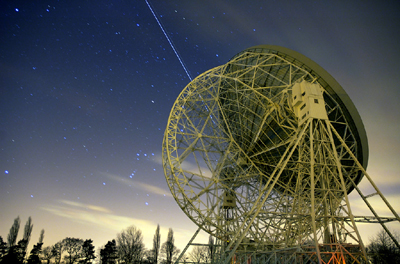
The International Space Station and Jules Verne passing behind the Lovell Telescope on April 1st 2008.
Image by Andrew Greenwood
Use the link below to find when the space station will be visible in the next few days. In general, the space station can be seen either in the hour or so before dawn or the hour or so after sunset - this is because it is dark and yet the Sun is not too far below the horizon so that it can light up the space station. As the orbit only just gets up the the latitude of the UK it will usually be seen to the south, and is only visible for a minute or so at each sighting. Note that as it is in low-earth orbit the sighting details vary quite considerably across the UK. The NASA website linked to below gives details for several cities in the UK. (Across the world too for foreign visitors to this web page.)
Note: I observed the ISS three times recently and was amazed as to how bright it has become.
Find details of sighting possibilities from your location from: Location Index
See where the space station is now: Current Position
The Moon
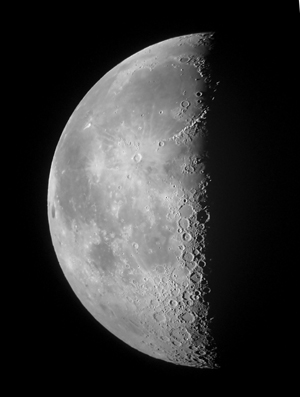
The Moon at 3rd Quarter. Image, by Ian Morison, taken with a 150mm Maksutov-Newtonian and Canon G7.
Just below the crator Plato seen near the top of the image is the mountain "Mons Piton". It casts a long shadow across the maria from which one can calculate its height - about 6800ft or 2250m.
| new moon | first quarter | full moon | last quarter |
|---|---|---|---|
| Sept 8th | Sept 15th | Sept 23th | Sept 1st |
Some Lunar Images by Ian Morison, Jodrell Bank Observatory: Lunar Images
A World Record Lunar Image
To mark International Year of Astronomy, a team of british astronomers have made the largest lunar image in history and gained a place in the Guinness Book of Records! The whole image comprises 87.4 megapixels with a Moon diameter of 9550 pixels. This allows details as small as 1km across to be discerned! The superb quality of the image is shown by the detail below of Plato and the Alpine Valley. Craterlets are seen on the floor of Plato and the rille along the centre of the Alpine valley is clearly visible. The image quality is staggering! The team of Damian Peach, Pete lawrence, Dave Tyler, Bruce Kingsley, Nick Smith, Nick Howes, Trevor Little, David Mason, Mark and Lee Irvine with technical support from Ninian Boyle captured the video sequences from which 288 individual mozaic panes were produced. These were then stitched together to form the lunar image.
Please follow the link to the Lunar World Record website and it would be really great if you could donate to Sir Patrick Moore's chosen charity to either download a full resolution image or purchase a print.
The Planets
Jupiter and, close by, Uranus.
Jupiter. Jupiter will rise in the east at ~21:00 BST and, at magnitude -2.9, will be well seen for much of the night. During the month it will gradually rise earlier and, by the end of the month, will rise about 19:00 BST. Jupiter comes to opposition on the 21st September so will be due south around midnight UT. It well worth observing with a telescope, as Jupiter has (presumably temporarily) lost its South Equatorial Belt and at the same time, the Great Red Spot has intensified its colour so is now standing out very well! A small telescope will easily pick up Jupiters four Galilean moons as they weave their way around it. Incidently, at opposition, Uranus, shining at magnitude +5.8 is less than a degree above Jupiter, so easily spotted in binoculars and both will be visible in the same field of view of a telescope. Much scope for some superb images!
See Highlight above.
Saturn
Saturn. Saturn passes behind the Sun on the 30th September but might just be glimpsed low in the west to the right of Venus during the first week or so. Better wait a month or so when it will be visible before dawn!
Mercury
Mercury passes behind the Sun (inferior conjunction) on September 3rd and then from the 9th until the end of September is visible in the pre-dawn sky. It reaches its greatest elongation from the Sun on the 19th when it has a magnitude of -0.4 and its illumination is just under 50%. From the 17th to the 25th, Mercury should be quite easy to spot at around 10 - 15 degrees elevation in the East. A small telescope should be able to show its phase increasing from a thin crescent on the 8th, some 10 arc seconds across, through to a gibbous phase, just 5.5 arc seconds across, by months end. This is Mercury's best dawn apparition this year as the ecliptic is at quite a high angle to the horizon.
See Highlight above.
Mars
Mars remains visible (at magnitude +1.5) in the south-west after sunset lying very close to Venus. Its angular size drops from 4.4 to 4.2 arc seconds during the month so any details on the surface will be impossible to spot. (Unless you have access the Hubble Space Telescope!)
See Highlight above.
Venus
Venus close to Mars, may be seen low in the west-southwest just after sunset. It reaches it greatest brightness, at magnitude -4.8 late in the month as its thin crescent increases in angular size.
See Highlight above.
Find more planetary images and details about the Solar System: The Solar System
The Stars
The Evening September Sky
This map shows the constellations seen towards the south in late evening. To the south in early evening moving over to the west as the night progresses is the beautiful region of the Milky Way containing both Cygnus and Lyra. Below is Aquilla. The three bright stars Deneb (in Cygnus), Vega (in Lyra) and Altair (in Aquila) make up the "Summer Triangle". East of Cygnus is the great square of Pegasus - adjacent to Andromeda in which lies M31, the Andromeda Nebula. To the north lies "w" shaped Cassiopeia and Perseus.
The constellations Lyra and Cygnus
This month the constellations Lyra and Cygnus are seen almost overhead as darkness falls with their bright stars Vega, in Lyra, and Deneb, in Cygnus, making up the "summer triangle" of bright stars with Altair in the constellation Aquila below. (see sky chart above)
Lyra
Lyra is dominated by its brightest star Vega, the fifth brightest star in the sky. It is a blue-white star having a magnitude of 0.03, and lies 26 light years away. It weighs three times more than the Sun and is about 50 times brighter. It is thus burning up its nuclear fuel at a greater rate than the Sun and so will shine for a correspondingly shorter time. Vega is much younger than the Sun, perhaps only a few hundred million years old, and is surrounded by a cold,dark disc of dust in which an embryonic solar system is being formed!
There is a lovely double star called Epsilon Lyrae up and to the left of Vega. A pair of binoculars will show them up easily - you might even see them both with your unaided eye. In fact a telescope, provided the atmosphere is calm, shows that each of the two stars that you can see is a double star as well so it is called the double double!
Between Beta and Gamma Lyra lies a beautiful object called the Ring Nebula. It is the 57th object in the Messier Catalogue and so is also called M57. Such objects are called planetary nebulae as in a telescope they show a disc, rather like a planet. But in fact they are the remnants of stars, similar to our Sun, that have come to the end of their life and have blown off a shell of dust and gas around them. The Ring Nebula looks like a greenish smoke ring in a small telescope, but is not as impressive as it is shown in photographs in which you can also see the faint central "white dwarf" star which is the core of the original star which has collapsed down to about the size of the Earth. Still very hot this shines with a blue-white colour, but is cooling down and will eventually become dark and invisible - a "black dwarf"! Do click on the image below to see the large version - its wonderful!
M56 is an 8th magnitude Globular Cluster visible in binoculars roughly half way between Alberio (the head of the Swan) and Gamma Lyrae. It is 33,000 light years away and has a diameter of about 60 light years. It was first seen by Charles Messier in 1779 and became the 56th entry into his catalogue.
Cygnus
Cygnus, the Swan, is sometimes called the "Northern Cross" as it has a distinctive cross shape, but we normally think of it as a flying Swan. Deneb,the arabic word for "tail", is a 1.3 magnitude star which marks the tail of the swan. It is nearly 2000 light years away and appears so bright only because it gives out around 80,000 times as much light as our Sun. In fact if Deneb where as close as the brightest star in the northern sky, Sirius, it would appear as brilliant as the half moon and the sky would never be really dark when it was above the horizon!
The star, Albireo, which marks the head of the Swan is much fainter, but a beautiful sight in a small telescope. This shows that Albireo is made of two stars, amber and blue-green, which provide a wonderful colour contrast. With magnitudes 3.1 and 5.1 they are regarded as the most beautiful double star that can be seen in the sky.
Cygnus lies along the line of the Milky Way, the disk of our own Galaxy, and provides a wealth of stars and clusters to observe. Just to the left of the line joining Deneb and Sadr, the star at the centre of the outstretched wings, you may, under very clear dark skys, see a region which is darker than the surroundings. This is called the Cygnus Rift and is caused by the obscuration of light from distant stars by a lane of dust in our local spiral arm. the dust comes from elements such as carbon which have been built up in stars and ejected into space in explosions that give rise to objects such as the planetary nebula M57 described above.
There is a beautiful region of nebulosity up and to the left of Deneb which is visible with binoculars in a very dark and clear sky. Photographs show an outline that looks like North America - hence its name the North America Nebula. Just to its right is a less bright region that looks like a Pelican, with a long beak and dark eye, so not surprisingly this is called the Pelican Nebula. The photograph below shows them well.
Brocchi's Cluster An easy object to spot with binoculars in Gygnus is "Brocchi's Cluster", often called "The Coathanger",although it appears upside down in the sky! Follow down the neck of the swan to the star Alberio, then sweep down and to its lower left. You should easily spot it against the dark dust lane behind.
The constellations Pegasus and Andromeda
Pegasus
The Square of Pegasus is in the south during the evening and forms the body of the winged horse. The square is marked by 4 stars of 2nd and 3rd magnitude, with the top left hand one actually forming part of the constellation Andromeda. The sides of the square are almost 15 degrees across, about the width of a clentched fist, but it contains few stars visibe to the naked eye. If you can see 5 then you know that the sky is both dark and transparent! Three stars drop down to the right of the bottom right hand corner of the square marked by Alpha Pegasi, Markab. A brighter star Epsilon Pegasi is then a little up to the right, at 2nd magnitude the brightest star in this part of the sky. A little further up and to the right is the Globular Cluster M15. It is just too faint to be seen with the naked eye, but binoculars show it clearly as a fuzzy patch of light just to the right of a 6th magnitude star.
Andromeda
The stars of Andromeda arc up and to the left of the top left star of the square, Sirra or Alpha Andromedae. The most dramatic object in this constellation is M31, the Andromeda Nebula. It is a great spiral galaxy, similar to, but somewhat larger than, our galaxy and lies about 2.5 million light years from us. It can be seen with the naked eye as a faint elliptical glow as long as the sky is reasonably clear and dark. Move up and to the left two stars from Sirra, these are Pi amd Mu Andromedae. Then move your view through a rightangle to the right of Mu by about one field of view of a pair of binoculars and you should be able to see it easily. M31 contains about twice as many stars as our own galaxy, the Milky Way, and together they are the two largest members of our own Local Group of about 3 dozen galaxies.
M33 in Triangulum
If, using something like 8 by 40 binoculars, you have seen M31 as described above, it might well be worth searching for M33 in Triangulum. Triangulum is
the small faint constellation just below Andromeda. Start on M31, drop down to Mu Andromedae and keep on going in the same direction by the same distance as you have moved from M31 to Mu Andromedae. Under excellent seeing conditions (ie., very dark and clear skies) you should be able to see what looks like a little piece of tissue paper stuck on the sky or a faint cloud. It appears to have uniform brightness and shows no structure. The shape is irregular in outline - by no means oval in shape and covers an area about twice the size of the Moon. It is said that it is just visible to the unaided eye, so it the most distant object in the Universe that the eye can see. The distance is now thought to be 3.0 Million light years - just greater than that of M31.

